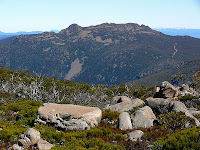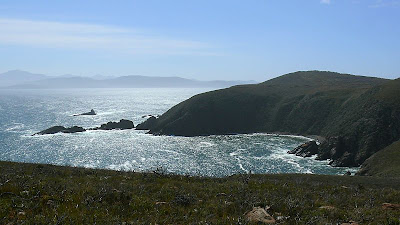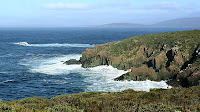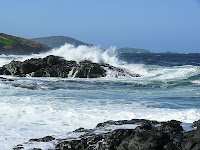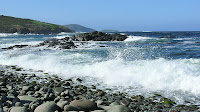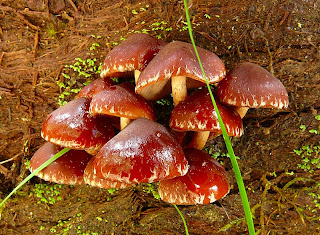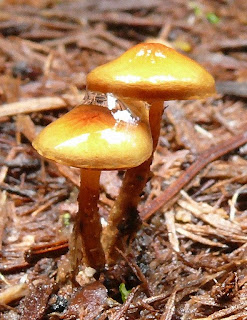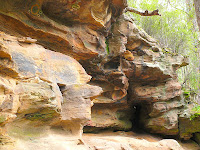Had a walk to
South Cape Bay on Saturday.
Map here. Earlier in the week the forecast for Saturday was a bit ordinary, but the outlook improved, and yesterday it was sunny all day.
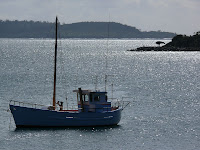 The whale sculpture at Cockle Creek makes an interesting silhouette. It's by Stephen Walker, who also did various other sculptures around Hobart and elsewhere. When it was erected, I think Peter Hodgman or John Cleary was minister for National Parks - I'm sure they were both implicated. It was just after they introduced the entry fees for National Parks, having promised to spend the fees on improving the "facilities". So then they spent $45,000 on this sculpture, which didn't fit most people's understanding of the term "facilities". In addition, the link between Recherche Bay and whales is that they used to hunt them from here. The grinning goons were roundly bagged in the Mercury, and rightly so.
The whale sculpture at Cockle Creek makes an interesting silhouette. It's by Stephen Walker, who also did various other sculptures around Hobart and elsewhere. When it was erected, I think Peter Hodgman or John Cleary was minister for National Parks - I'm sure they were both implicated. It was just after they introduced the entry fees for National Parks, having promised to spend the fees on improving the "facilities". So then they spent $45,000 on this sculpture, which didn't fit most people's understanding of the term "facilities". In addition, the link between Recherche Bay and whales is that they used to hunt them from here. The grinning goons were roundly bagged in the Mercury, and rightly so.
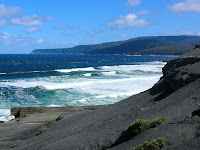 Having walked from Cockle Creek for a bit over an hour and a half, you emerge on these black, shaly cliffs, at the eastern end of South Cape Bay beach. The bay extends further eastwards towards South East Cape, the most southerly part of mainland Tasmania. To the west of the bluff lies the beach, reached by carefully walking around the black, gravelly cliffs and descending a set of steps to the beach. The waves were quite impressive yesterday, long slow swells were breaking into huge, streaky curlers a long way from the beach. Nobody was surfing. Beyond the bay, South Cape stretches into the Southern Ocean (background of the photo). To visit South Cape requires a lengthy off-track scrub-bash from where the South Coast track crosses the South Cape Range. I understand the South Coast Track is to be re-routed to pass much closer to the Cape, and this will make for a much drier, more enjoyable and much more scenic walk.
Having walked from Cockle Creek for a bit over an hour and a half, you emerge on these black, shaly cliffs, at the eastern end of South Cape Bay beach. The bay extends further eastwards towards South East Cape, the most southerly part of mainland Tasmania. To the west of the bluff lies the beach, reached by carefully walking around the black, gravelly cliffs and descending a set of steps to the beach. The waves were quite impressive yesterday, long slow swells were breaking into huge, streaky curlers a long way from the beach. Nobody was surfing. Beyond the bay, South Cape stretches into the Southern Ocean (background of the photo). To visit South Cape requires a lengthy off-track scrub-bash from where the South Coast track crosses the South Cape Range. I understand the South Coast Track is to be re-routed to pass much closer to the Cape, and this will make for a much drier, more enjoyable and much more scenic walk.
 I'm always interested to see what shape the beach is in when I walk here. Last time the sand was reasonably well spread along the beach, and before that. there was a huge spit where the sand had collected in the middle of the beach. This time the sand has migrated to the ends, and away from the middle. The rocks and boulders at the east end were well covered by sand.
I'm always interested to see what shape the beach is in when I walk here. Last time the sand was reasonably well spread along the beach, and before that. there was a huge spit where the sand had collected in the middle of the beach. This time the sand has migrated to the ends, and away from the middle. The rocks and boulders at the east end were well covered by sand.
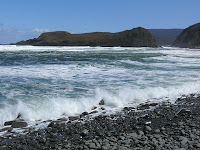 However, in the middle there was no sand and the waves were breaking on a steep shore of rounded pebbles, similar to the situation at Granite Beach on the far side of the South Cape Range. At the western end, there was more sand than usual. I must find out what conditions cause sand to collect in the middle or at the ends of beaches. Very interesting.
However, in the middle there was no sand and the waves were breaking on a steep shore of rounded pebbles, similar to the situation at Granite Beach on the far side of the South Cape Range. At the western end, there was more sand than usual. I must find out what conditions cause sand to collect in the middle or at the ends of beaches. Very interesting.
 I often wonder where all the different stones come from on a beach. I have a feeling these are both dolerite, but just weathered differently.
I often wonder where all the different stones come from on a beach. I have a feeling these are both dolerite, but just weathered differently.
 Lion Rock is made of dolerite. It makes a very imposing sight at the far end of the first beach. The brown stain in the creek is from the tannin in the water. Looks terrible in a clear water bottle, but the water tastes great, and is fine for drinking.
Lion Rock is made of dolerite. It makes a very imposing sight at the far end of the first beach. The brown stain in the creek is from the tannin in the water. Looks terrible in a clear water bottle, but the water tastes great, and is fine for drinking.
 This log has been washing around the western end of the bay for a while. It appears to have been moved several times by storms, as it is normally found in various places quite high above the waterline, but then one day it will be somewhere else. Makes a good seat anyway.
This log has been washing around the western end of the bay for a while. It appears to have been moved several times by storms, as it is normally found in various places quite high above the waterline, but then one day it will be somewhere else. Makes a good seat anyway.
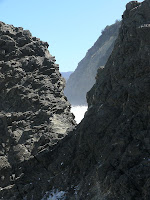 This is the low-level route below Coal Bluff, which forms an alternate (not recommended) part of the South Coast Track. I've not walked it. The water always seems to be high enough to make it wet. It was yesterday, with the waves washing up to the cliffs just beyond this notch, and that wasn't even high tide. It can be very dangerous below here, and people have been swept away. This notch was apparently blown with explosives sometime after WW2, so says Ron Woolley.
This is the low-level route below Coal Bluff, which forms an alternate (not recommended) part of the South Coast Track. I've not walked it. The water always seems to be high enough to make it wet. It was yesterday, with the waves washing up to the cliffs just beyond this notch, and that wasn't even high tide. It can be very dangerous below here, and people have been swept away. This notch was apparently blown with explosives sometime after WW2, so says Ron Woolley.
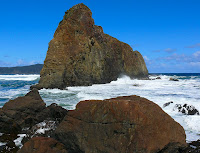 Lion Rock is quite interesting from close up. It's worth walking beyond the end of the beach, tide and waves-permitting, and scrambling along the boulders to get the end-on view of Lion Rock. It really is a very thin strip of dolerite poking out into the bay, and end-on with decent waves and nice light it can be quite dramatic.
Lion Rock is quite interesting from close up. It's worth walking beyond the end of the beach, tide and waves-permitting, and scrambling along the boulders to get the end-on view of Lion Rock. It really is a very thin strip of dolerite poking out into the bay, and end-on with decent waves and nice light it can be quite dramatic.
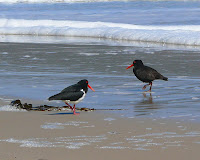 These oystercatchers were among various bird species on the beach. There were no Hooded Plovers today, not sure where they might be. Maybe somewhere warmer. Interestingly there were two Pied Oystercatchers (Haematopus longirostris) and a single Sooty (Haematopus fuliginosus) hanging around in a small group.
These oystercatchers were among various bird species on the beach. There were no Hooded Plovers today, not sure where they might be. Maybe somewhere warmer. Interestingly there were two Pied Oystercatchers (Haematopus longirostris) and a single Sooty (Haematopus fuliginosus) hanging around in a small group.
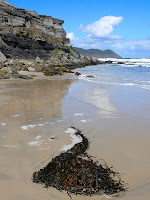 The crumbling cliffs at the eastern end of the beach look ready to collapse, and I suppose every now and then they do. Hope I'm not there when it happens. Beyond them can be seen South East Cape. I understand someone has cut a track to it. I hear it might be the same bloke who cut the track from Cook Creek to Mt Picton. Anyway, I just have to try to find the start of the track along the shore, on a day with a good low tide! It used to be a nightmare dry scrub-bash, attempted only occasionally.
The crumbling cliffs at the eastern end of the beach look ready to collapse, and I suppose every now and then they do. Hope I'm not there when it happens. Beyond them can be seen South East Cape. I understand someone has cut a track to it. I hear it might be the same bloke who cut the track from Cook Creek to Mt Picton. Anyway, I just have to try to find the start of the track along the shore, on a day with a good low tide! It used to be a nightmare dry scrub-bash, attempted only occasionally.
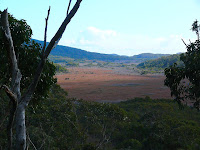 This is the view up Blowhole Valley between Cockle Creek and South Cape Bay. The track along the valley is very well duckboarded now, but it used to be a deep-mud slog. Cows once grazed here, perhaps not very successfully, and a fenceline can be seen about halfway up the valley (as you walk, not in the photo).
This is the view up Blowhole Valley between Cockle Creek and South Cape Bay. The track along the valley is very well duckboarded now, but it used to be a deep-mud slog. Cows once grazed here, perhaps not very successfully, and a fenceline can be seen about halfway up the valley (as you walk, not in the photo).




